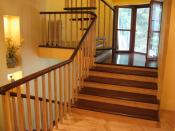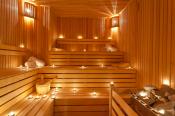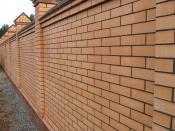Search
Login
Swimming pool from foundation pit to equipment
Over the past decade, private small pools are becoming more and more active. Ecology is deteriorating, water bodies are polluting, and in the summer everyone wants to swim. In this article, we will briefly talk about all the stages of the construction of the pool.
Content
- What will be the pool? video
- Creating a reinforced concrete bowl
- Plastering the surface of the pool and installing embedded elements
- Waterproofing the future pool
- Pool lining
- Equipment installation video
- Commissioning works
What will be the pool?
If you decide to get a pool, and a pool outdoors in the summer is a source of health and a true pleasure in the heat, you must clearly determine the type of pool.
Stationary or prefabricated, under a roof or in the fresh air, how many people will use it, what is the volume of the proposed pool.
A significant role is played by the simultaneity of building a house and a pool, or: a house is built - a pool is being built later.
You can solve all these issues yourself, and the pool itself can be built independently by studying the information in the literature or on the Internet and consulting with specialists.
But if finances allow and you know reliable specialists, entrust this work to professionals.
A specialized company will take into account all your wishes, perform a hydrological survey of the site, and present you with a draft and estimate documentation.
If everything suits you, the team starts work.
Creating a reinforced concrete bowl
You decided to make a stationary pool.
For stationary basin, in accordance with the size, digging a pit. If you decide to make the pool bowl from polypropylene, then under the bottom of the bowl, you need to make a concrete pillow, using reinforcement, pour concrete, level the surface and thus create a pillow 20-30 cm thick.
Next, a polypropylene bowl is made, installed in the pit, then specialists install all the embedded elements.
The next step is the insulation of the side walls of the bowl in the form of a layer cake, all of which are described in detail on the Internet.
The equipment is installed and connected, the pool filled with water is checked in operation.
The second option for the pool is a pool of reinforced concrete bowls.
The technology for manufacturing a reinforced concrete bowl is well known: formwork is done, reinforcement is placed and all this is poured with concrete.
The main point is to obtain a monolithic product.
To get a long-lasting and reliable structure, pouring is best done not in parts, but to do everything at once.
Now give time for the ripening and solidification of concrete.
Plastering the surface of the pool and installing embedded elements
The solution is prepared in accordance with the instructions indicated on the plaster label.
It is good when this plaster has special additives with adhesive and waterproofing properties.
Before work, the surface of the bowl must be dusted and moistened.
It is very good if the linear dimensions of the pool are multiples of the dimensions of the tiles or mosaics.
The plaster should level the surface, if the future pool is overflow, then the horizontal of the upper edges should be accurate to plus, minus 1 mm.
The plaster must be very strong, if it is made without a reinforced mesh, its thickness should not exceed 3 cm.
The plaster must hold the dowels in which the corners will be attached, and to them, in the future, the film will be welded.
After carrying out high-quality plaster, they begin to install embedded elements: nozzles, spotlights, skimmers, etc.
Installation should be made so that after facing the pool, the embedded element should be in the plane of the tile or mosaic.
After installing the mortgages, the holes are closed with plywood shields, and the free volume that remains after the mortgages is filled with a hydrophobic composition.
Waterproofing the future pool
Before proceeding with waterproofing, the plastered surface of the bowl is cleaned of dust with vacuum cleaners and moistened.
The insulation includes three layers, after applying each layer, withstand a time interval of at least 5 hours, before applying the next layer.
The first layer is necessarily reinforced with a 5x5 mm fiberglass mesh.
After laying all three layers, the process of drying and polymerization of the coating takes place within 4-5 days.
Next, the cup is filled with water, kept for 14 days, if there are no leaks, proceed to the next work.
Pool lining
The cladding should be beautiful and at the same time possess technological protection.
The best materials are ceramic tiles and mosaics.
These materials have good strength, abrasion resistance and practically do not absorb water, have great resistance to ultraviolet and frost.
If the finishing material is polyvinyl chloride film, it is also waterproofing and facing layer - such a pool can only be lined with waterproofing from the outside.
The film is laid quickly, but it must be protected from cuts.
Tiles and mosaics are fastened with two-component glue, the seams are rubbed with the same composition.
Equipment installation
Installation of equipment can be carried out simultaneously with the lining of the bowl. The main equipment is:
- filters - they purify water;
- heat exchangers - produce water heating from the heat circuit of the house or electric heaters.
Additional equipment can be installed to increase comfort and care for the pool:
- reagent dosing station;
- ultraviolet system, etc.
After installing embedded parts, pipes and cables are mounted around the pool, and wiring is made to the technical room.
After tying the bowl, the equipment is installed in the technical room: filters, heat exchangers, disinfecting installations.
Commissioning works
After installation and installation of all devices provided for by the project, commissioning and commissioning are carried out.
By this time, water, electricity, ventilation and sewage should be supplied.
The direction of rotation of the three-phase electric motors of the pumps is checked, the internal surface of the pool is cleaned of contaminants, and it is treated with a special solution to prevent the development of microorganisms.
After this solution dries, the pool is filled with water to a depth of 20 cm.
All equipment, automation and sensors are checked again. Then the pool is completely filled with water.
All documentation is handed over to the customer.





